Warcraft Retrospective 7: Reconquista
Just like in Warcraft 1, the two sides in Warcraft 2 are only cosmetically different except for caster units.
Just like in Warcraft 1, the two campaigns in Tides of Darkness tell opposite stories. The orcs aim to conquer a land, while the humans aim to defend the same land and end the orcish threat.
To my surprise, the human campaign is not an almost-exact mirror opposite of the orc one gameplay-wise, like it was the case with Warcraft 1. Let’s dive in…
But first, I should once again praise the soundtrack. Imagine that you start your first mission, get your stock mission objective to “build four farms, build a barracks”, and get a minimal base of a town hall and a couple peasants and footmen. And then this music hits you.
Like I said, my copy of Warcraft 1 in my childhood didn’t play music. Now I know what I missed. I first heard this track as pet battle music, and have remembered it ever since. My heart races with joy whenever I hear it in a Warcraft game — including Hearthstone, where it was rearranged a second time as the matchmaker theme.
The Alliance Units
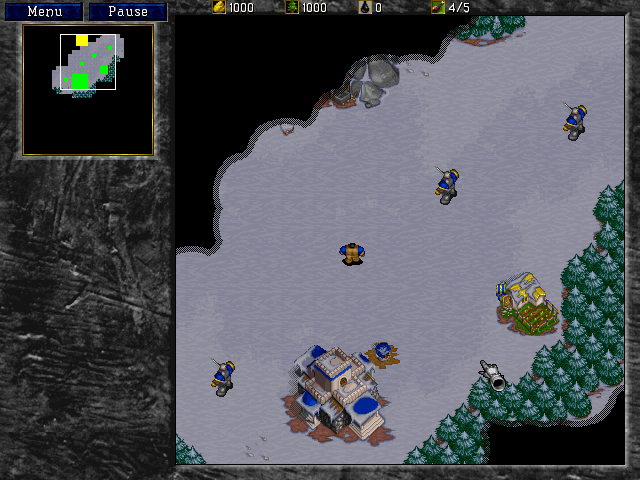
I appreciate how the Alliance has actually been made to feel like an alliance. You get a feeling that these units come from not only different races, but different nations as well. The peasants speak with a really thick accent (“Yesh, meelord”) — I actually didn’t at first realize that their building completion sound was the iconic “Job’s done” because of the hard-to-understand accent. The knights have the crest of Lordaeron on their shields. The ship crews ask for orders with “Aye, captain” and acknowledge them with “Aye, aye, sir”. Overall, the voice acting is pretty fun and varied.1
On the non-human front, dwarves look straight out of The Lost Vikings, with their horned helms and overall boisterous attitude. Elves are… interesting. Their unit portraits are more Tolkien/D&D style than later Warcraft, relatively human-like with relatively short ears, but their map sprites — though it’s hard to see because of how pixelated they are — have the ridiculously long ears we know from later Warcraft games, perhaps to make them more distinct given the limited resolution.
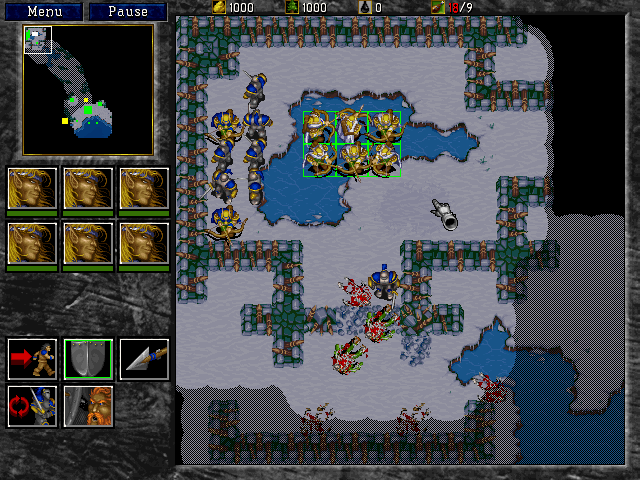
Like with Horde buildings and units, the designers of the Alliance ones did an excellent job making them as distinct as possible, as well as making unit colors easy to scan, which is important when you face enemies of the same faction.
The Human Missions
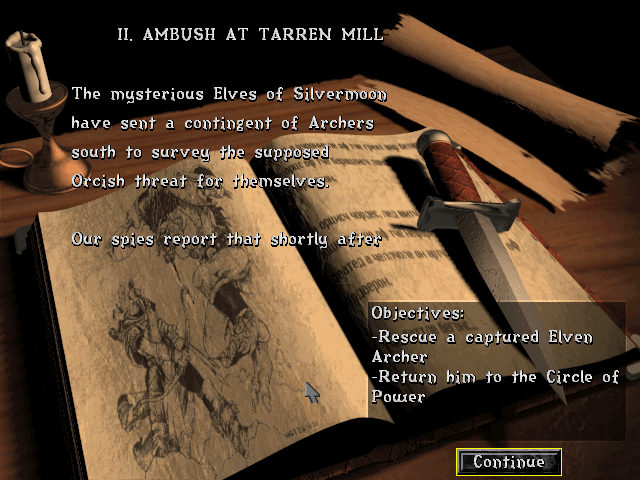
The orc and human campaigns seem to have had different designers, as they show different sensibilities. Most orc missions follow the “build a base on your island, then attack the enemy island by sea” formula. The orc map designer liked a single body of open water with islands strewn throughout. The human one, on the other hand, prefers maze-like designs built like puzzles, with space-filling paths and coasts with sheer cliffs that you sail along trying to find the one spot where you can actually land.
Overall I found the human campaign more fun. It’s refreshing enough that the campaigns aren’t exact mirror opposites. It’s doubly refreshing that the human campaign designer saw that the island formula was growing stale, and took steps to bring variety with exploration puzzles, a higher amount of navy-free maps, and non-standard mission objectives.

- You2 prove how different you are from the orcs by doing exactly the same thing: building four farms and a barracks. But it’s okay because you build them to defend Hillsbrad, not invade it.
- The elves of Silvermoon, not yet part of the Alliance, have sent archers to scout orc movements by themselves, but they were caught in a Horde trap at Tarren Mill. At the behest of Lord Terenas, you rescue six captured elven archers (with no named characters) and escort them to the Circle of Power.
- In their gratutide, the Council of Silvermoon entrusts their armies to the Alliance, sending a fleet of elven destroyers to Lordaeron. Lord Admiral Daelin Proudmoore of Kul Tiras orders you to build a shipyard and four oil platforms.
- Having built up your fleet, you destroy the orc base on the island of Zul’dare south of the Lordaeron coast.
So far, the objectives of these missions mirror those of the corresponding orc ones.
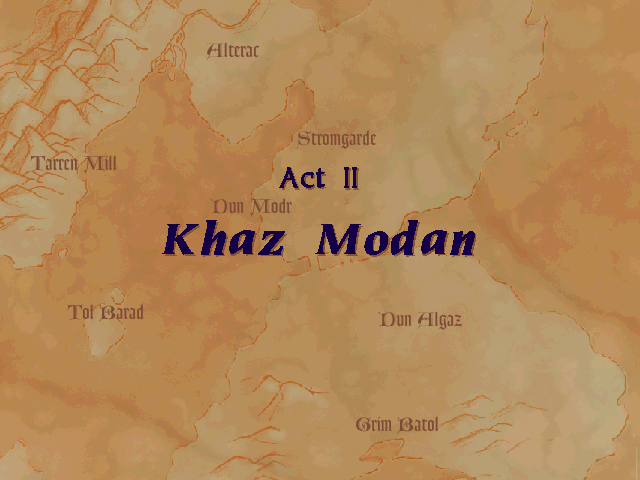
-
You reclaim the island keep of Tol Barad, which belongs to Stromgarde, and destroy the orc base near the ruined dwarven city of Dun Modr.
This is an interesting mission. It takes place on a map that is almost, though not exactly, the same as in the corresponding orc mission, and the goal is diametrally opposed. The orcs start their mission without a base and have to raze a small human one before they can set up theirs. You, however, can have a relatively developed base from the get go… if you’re quick enough about it. The idea is to immediately load your starting troops onto transports and go help the red base on the nearby island fend off an orc attack. Once you approach the red (Stromgarde) buildings and units, they flip to your side.
Unlike in Warcraft 3, when units and buildings switch sides, they do not change color, but otherwise start acting like units of your color. For example, this red town hall under the control of me, the blue player, produces blue peasants. If I ask a red peasant under my control to construct a building, it will be blue. It’s a fun cosmetic detail.
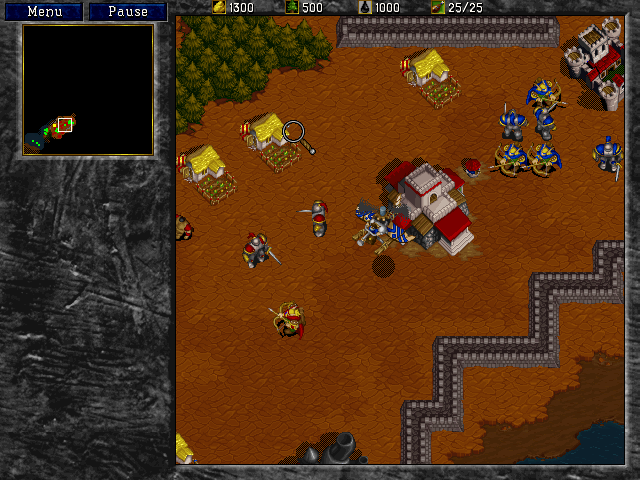
-
With Dun Modr destroyed, you cross the Thandol Valley to destroy the secondary orc base as Dun Algaz. You get knights. There is no navy-building in this mission — we just cross the land bridges and attack.
From a modern perspective, these two missions are a continuity nightmare. The Thandol Span, not yet named that, is three bridges that are rendered as dirt on the actual map because of tileset limitations. Dun Modr is north of the Thandol Span, not south. And, of course, Tol Barad is just west of Dun Modr instead of way out there in the Great Sea.
-
You advance farther south and destroy the oil refineries at Grim Batol.
This is a really interesting mission in that it’s as much an exploration mission as it is a combat one, and it employs unorthodox map design. You start in the upper left corner, with no base and no idea where to even found one. The game rewards you for exploring the narrow strip of land in the west by giving you lightly guarded catapults. To actually build a base, you have to transport your land units across a narrow strait, find the one spot where you can land, then raze the existing orc base there and build your own in its stead. And then you will need to build a shipyard to operate in the unconnected body of water in the east. Your stated objective is only to destroy the oil refineries there — but there is a second orc base with a powerful fleet in the way, just waiting for you to try.
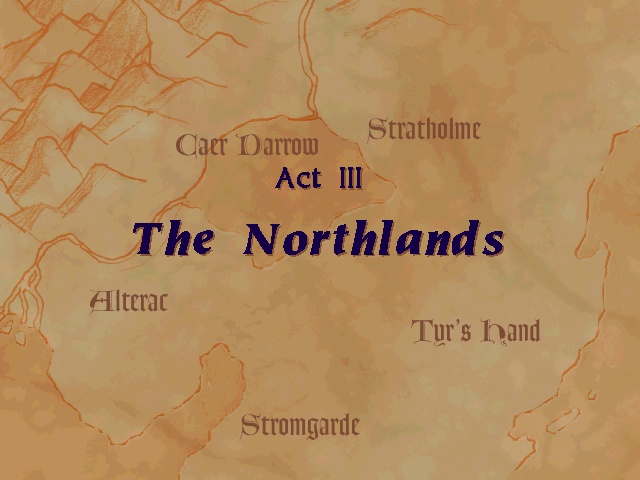
Unlike pretty much everything else in Warcraft 2, this campaign act employs — gasp — foreshadowing!
- We are asked to put quell a peasant uprising in Tyr’s Hand. And by “quell”, the game means kill the revolting peasants. (Wait, what? Aren’t we supposed to be the good guys?) The good news is that after you’re done massacring human civilians, a bare-bones base with natural defenses flips to your control, including some non-revolting peasants. After that, it’s the standard “destroy all enemies” — except it’s on an all-land map with maze-like paths separated by cliffs, and you face three orc clans at once.
-
You escort Uther Lightbringer, commander of the paladins and the Archbishop’s assistant, to offer comfort to the suffering citizens of the northlands. Just like the orc campaign had you escort a unique ogre-mage, here you escort a unique paladin, but with a twist.
You have a limited army and navy and can’t build a base. Uther starts on a separate island that’s behind a narrow strait controlled by orc fortifications, and the destination circle of power is on a different separate island that’s behind another narrow strait controlled by orc fortifications. You have to break through the blockade, move your transports to Uther’s island, pick him up, break through another blockade and reach the destination island — wait, are these human ships attacking us?
That’s right — after you break through the orc blockade, you face a surprise encounter with Alliance ships under the orange colors of Alterac. It’s nice that an important plot point is conveyed here with gameplay mechanics and no narration.
-
The renegades of Alterac have been rounded for questioning, and need to be brought to the capital of Lordaeron. You start at Stratholme, and the renegades are represented by eight orange peasants that cannot do anything except move and stop. You need to bring at least four of them to a Circle of Power.
This is another exploration puzzle mission. You are told to build transports and ferry the renegades to your base, but there is a strip of land in the way that cannot be circumvented, separating two disconnected bodies of water. You have to find — once again — the one spot you can land, which is occupied by an orc base, raze it, then build a second shipyard on the other side of the strip of land so you can build transports there. Then you need to force your way through a gauntlet of Horde towers in a winding strait, reach the renegades, and transport them back to the former orc base — so they can cross the land, board your original transports, and finally reach your base.
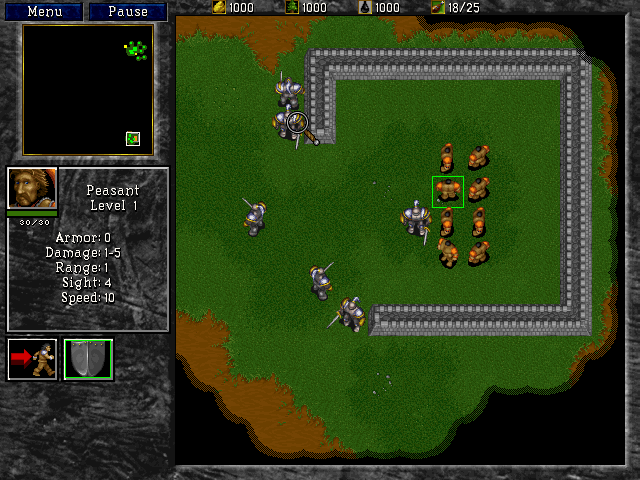
-
Finally, it’s time for the obligatory Civil Warcraft mission.
You learn that Alterac has betrayed the Alliance. Lord Perenolde was working with the Horde since the beginning of the war; he ratted the elves from the second mission out to the orcs and was behind the peasant revolt, which aimed to draw attention away from an orcish mining facility. With this revelation, you rescue some Dalaranian mages and peasants from an Alteraci prison, then destroy the capital city of Alterac.
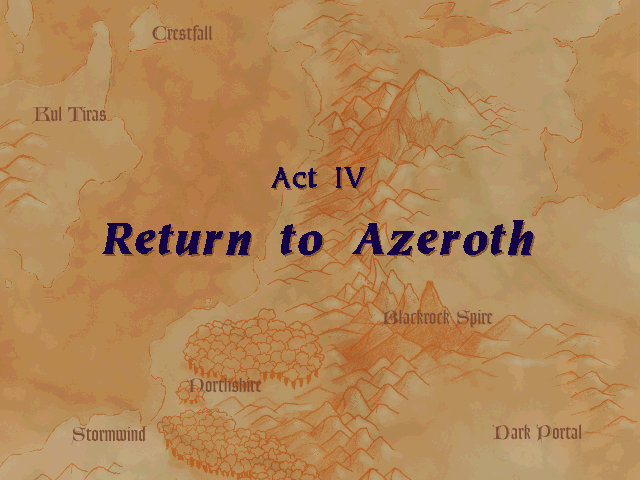
- Before the push south can begin, you need to destroy Horde holdings at Crestfall. This is a straightforward islands-type mission, with the wrinkle that you don’t strictly have to destroy the entire enemy base, only cripple their naval power. Specifically, you need to destroy all orc transports, shipyards, and oil derricks [sic].
-
Lord Lothar attempted to parley with Orgrim Doomhammer, but was not heard of for days. “Assuming the worst, Admiral Proudmoore and King Terenas agree that it falls upon you to stage a final siege upon Blackrock Spire.”
When you begin this mission, Lothar and his three knights start in their own corner of the map and are immediately assaulted and killed by an overwhelming Horde force. Poor Lothar. For all his hyped-up badassery throughout two games, he dies in gameplay to random grunts, axethrowers, and ogres. He isn’t even under your control, unlike the three knights, so you cannot immediately micromanage him away (not that it would help) — he just makes his last stand and fights to the death.
Once that cruel twist is done with, it’s another islands-type mission with you against an insane number of separate Horde bases you have to destroy. It’s supposed to be Blackrock Spire, though the geography here is nothing like either Warcraft 1 or WoW.
-
For the campaign finale, you have to destroy the Great Portal to cut the Horde off from reinforcements from their world.
Once again, the geography is completely out of whack here, featuring water, and the creator of the space-filling path missions has struck again. You start without a base. You have to cross a body of water to find… you guessed it, one landable spot that isn’t overtaken by sheer cliffs. And it’s occupied by an orc base. Once you raze that one and build yours, you need to destroy another, stronger orc base on the same strip of land, build a shipyard on a disconnected body of water, cross that, find another small landable spot, destroy another orc base… and then the Portal itself is in the middle of an inland lake, guarded by death knights and flying daemons, so you have to build ships to cross that too.
…Or you could send mass gryphon riders to that central island, I suppose.
Try finding any of that water in the modern Blasted Lands! Or on the Warcraft 1 map, for that matter.
With the Portal destroyed, a victory cutscene plays. It turns out you didn’t actually destroy the Portal, it still stands, so that an unnamed human mage can destroy it in a cinematic.
Quiet settles over the Black Morass with the blackened, burning remains of the cursed Portal serving as a solemn reminder of the evil that once stood here. After the long and savage battle, you stand victorious over the tattered remnants of the once mighty Orcish Hordes. Those Orcs that survived the conflict have fled to the northeast in hopes of escaping your vengeance. You allow them their reprieve, knowing that the power of the Horde has been forever broken and that the lands of Azeroth belong to its native sons and daughters once again.
No obvious sequel hook for this side, either!
Closing Thoughts on Tides of Darkness
The Tides of Darkness campaigns are a massive improvement over Warcraft 1 in fun, variance, and strategic depth — but there’s no way I see myself replaying them. They are very time-consuming, with so much of the playtime occupied by non-strategic actions like base ramp-up and hunting the last few enemy units, and have very little to show for it story-wise to a modern player.
There is also a more important, thematic complaint I feel I should make about both Warcraft 1 and 2.
In both games, the two campaigns are very different in premise. The orcs are invaders conquering someone else’s land, while the humans are defending their lands and trying to drive the invaders out. Stories this different should feel different. Somewhere in the background, the orcs are sacking peaceful villages and slaughtering or enslaving civilians, while the humans are retaking what’s left of the villages and presumably rescuing slaves and prisoners when they can. We are told that in mission briefings, but it’s not seen in the gameplay. The game tells us that the stories are morally very different, but doesn’t show it.
Of course, it can’t, because of technical limitations. Invader footholds in foreign lands are portrayed as military bases — and the towns of the people who had always lived there are portrayed as military bases too. The campaign missions play cosmetically different, and it can create an impression that the stakes are cosmetically different, too, that the main difference between the two campaigns is that one side has green skin and fangs and the other doesn’t.
It will be some time before a Warcraft RTS will portray committing monstrous acts in a way that actually makes them feel monstrous.
Warcraft 2 continues the black-and-white morality of Warcraft 1, but it injects just a little nuance. As a rule, humans are still good and orcs are still evil, but some humans are traitors, and even the non-traitors crush peasant revolts with military force. And some orcs are more vile than others, in that they only care about personal powers and are willing to secretly manipulate their own kind on behest of demons. And sure, Gul’dan believes that savagery and rule of the strong are in the orcs’ nature, but would you trust Gul’dan to form an objective opinion about anyone at all?
Thanks to the unreliable narrator device, if the next writer wanted to portray the orcs with more nuance, they would not even have to retcon anything.
What’s Next?
We are not done with Warcraft 2 yet.
Warcraft 1 had two possible endings, in one of which the orcs conquered the Kingdom of Azeroth, and in the other they were driven back to their world. When I said Blizzard chose to make a sequel to the first of these two endings, I simplified things a little. In reality, they chose…
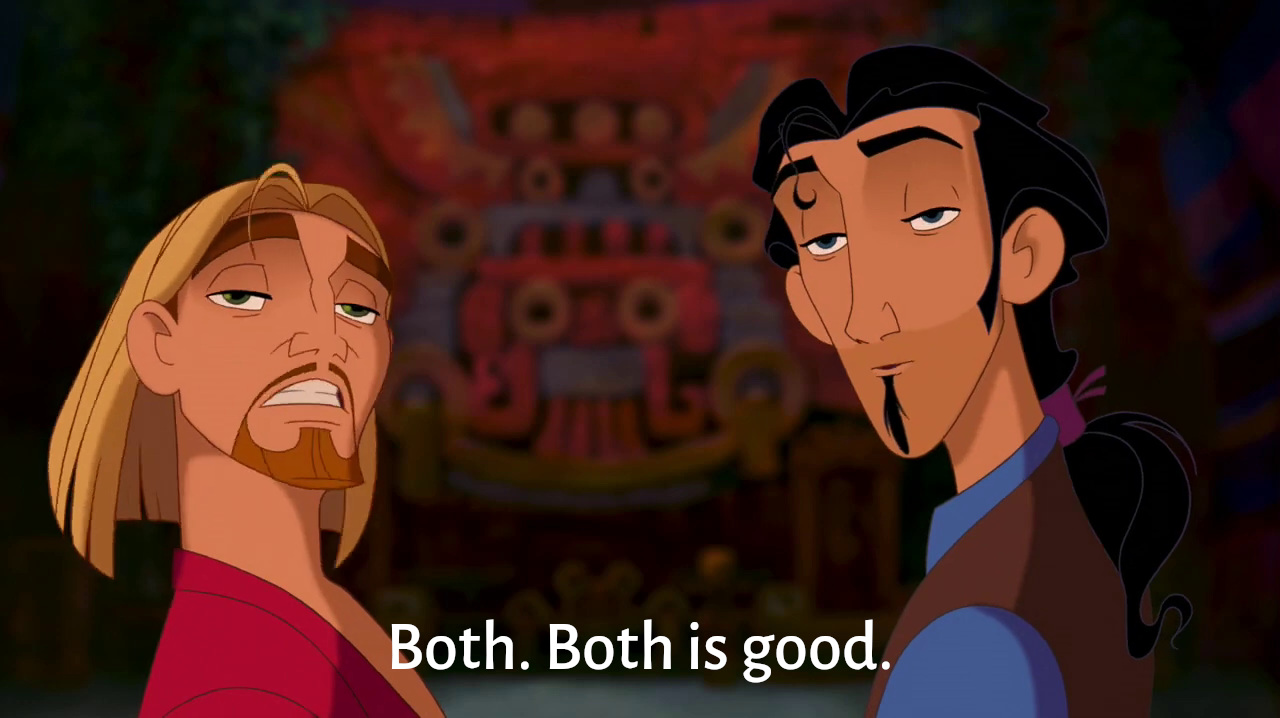
But to make a sequel to the other ending, they had to wait until Warcraft 2 got an expansion.
Next time: Beyond the Dark Portal!
-
Interestingly, the quotes for all ships are the same, including the Elven Destroyer — implying, perhaps, that they’re ships of elven design crewed by humans? Or did they simply not bother to record separate voice lines? ↩
-
Who exactly “you” are is once again unclear, though the novel adaptation seems to have gone with one possibility. ↩
Comments
Syal
A fun note; Lothar’s death is a requirement for victory on his map. If you use the invincibility code to keep him alive, the map doesn’t end until you kill him yourself.
Leave a Comment